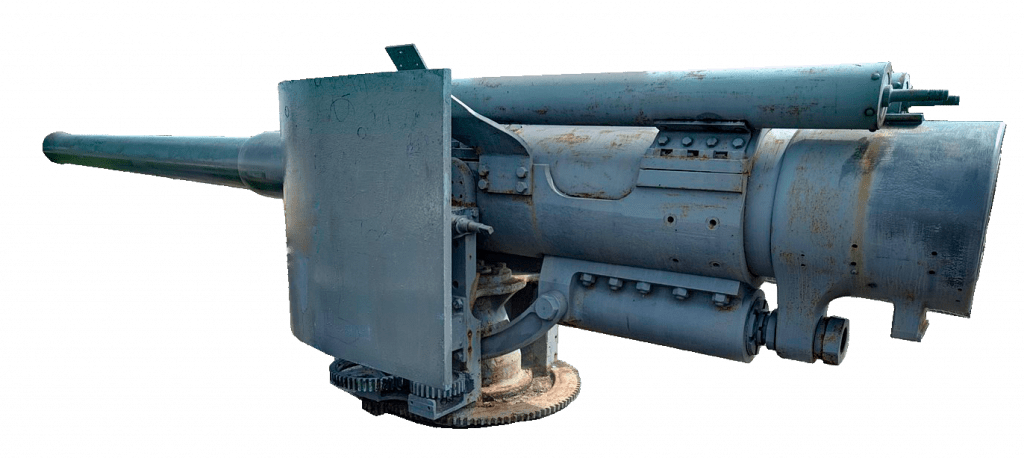
The 6 inch coast gun first entered service in 1882 as the “80 pdr”. It was the first gun in British service to use the interrupted screw breech. A large number of variants were produced over its service but by 1939 only a few remained in use as the role of the gun had reduced to close defence and Examination Batteries.
During the war a small number of Naval 6 inch guns of an advanced design were used in coastal defence. These guns were able to achieve an elevation of 45º allowing them to fire at extreme range. They were emplaced on the South East and East coasts of England coupled with coast watch radar. This allowed long range engagement of enemy shipping in the English Channel as well as their usual defence duties.
Gun
| Mark 7 | Original model of 1898 |
| Mark 7* | Mk 7 relined with new inner “A” tube in 1939 |
| Mark 7V | Similar to Mk 7 but different construction. Only 12 made in 1900 |
| Mark 7V* | Mk 7V relined as for Mk 7* |
Mounting
Ordnance BL, 6 inch Wire Mark 7 on Carriage, Garrison, BL, 6 inch
Central Pivot Mark 2
Introduced in 1898 with some remaining in service until 1956. The gun was wire wound 45 calibre. It had an interrupted screw breech and was the first Welin screw to see service.
The mounting was a pedastal bolted to a holdfast, carrying the carriage body in a pivot at the top. Platform and shield rotated with the carriage. The gun was controlled by a hydraulic recoil buffer and two spring recuperators
The mounting was in a concrete emplacement with the gun layers on the gun platform and the rest of the detachment on the emplacement floor below.
| Mark 2 | As above |
| Mark 2A | Conversion of QF 6 inch mounting |
| Mark 4* | Mark 4 mounting fitted with short Mk 2 cradle |
Data
| Weight of gun & breech mechanism | 16,575 lbs |
| Total length | 279.228 inches |
| Length of Bore | 269.5 inches (45 calibre) |
| Rifling | 36 grooves. Straight to 211.06 inches from muzzle, then increasing to 1/30 at muzzle |
| Breech mechanism | Welin interrupted screw, electric & percussion fired |
| Elevation | -10º to +16º with shield, +20º without |
| Traverse | 360º |
| Recoil system | Hydro-spring constant, 18 inches |
| Weight in action | 35,896 lbs |
Performance
Firing standard 100 lbs piercing shell
| Muzzle velocity | 2,538 feet per second |
| Maximum range | 14,000 yards |
Ordnance BL, 6 inch Mark 24 on Mounting, 6 inch Marks 5 or 6
An updated version of the Mark 7 but built up with an auto-frettaged loose barrel and jacket. The breech mechanism was an Asbury pattern the same as the 4.5 inch Medium Gun but with an electric and percussion firing lock.
The mounting Mark 5 was the Mark 2 updated but with an all-enveloping gun house type shield and the ability to elevate to 45º. There was also a Mark 6 Mounting, being a Mark 5 but with its cradle being of cast steel instead of built up from forgings.
Data
| Weight of gun & breech mechanism | 16,740 lbs |
| Total length | 279.228 inches |
| Length of Bore | 269.5 inches (45 calibre) |
| Rifling | 36 grooves. Uniform Right Hand 1/30 at muzzle |
| Breech mechanism | Asbury interrupted screw, electric & percussion fired |
| Elevation | -10º to +45º |
| Traverse | 360º |
| Recoil system | Hydro-pneumatic constant, 19.4 inches |
Performance
Firing standard 102 lbs shell with HV charge
| Muzzle velocity | 24,000 yards |
| Maximum range | 24,500 yards |
Ammunition
| Shell, APC Mark 7 | A piercing shell using Percussion Base Fuse No. 16 |
| Shell, CPBC Mark 36B | Similar to the APC round but without the penetrating cap. Designed for use against lightly armoured or unprotected ships |
| Shell, HE Mark 29B | Conventional nose fused HE shell for use against unarmoured ships and land targets |
| Propelling Charge | Silk-cloth bag containing 22.25 lbs of Cordite. A HV (High Velocity) charge was available for the Mk 24 gun on Mk 6 mounting. It contained 31 lbs of Cordite abd was only used for extreme range firing |
